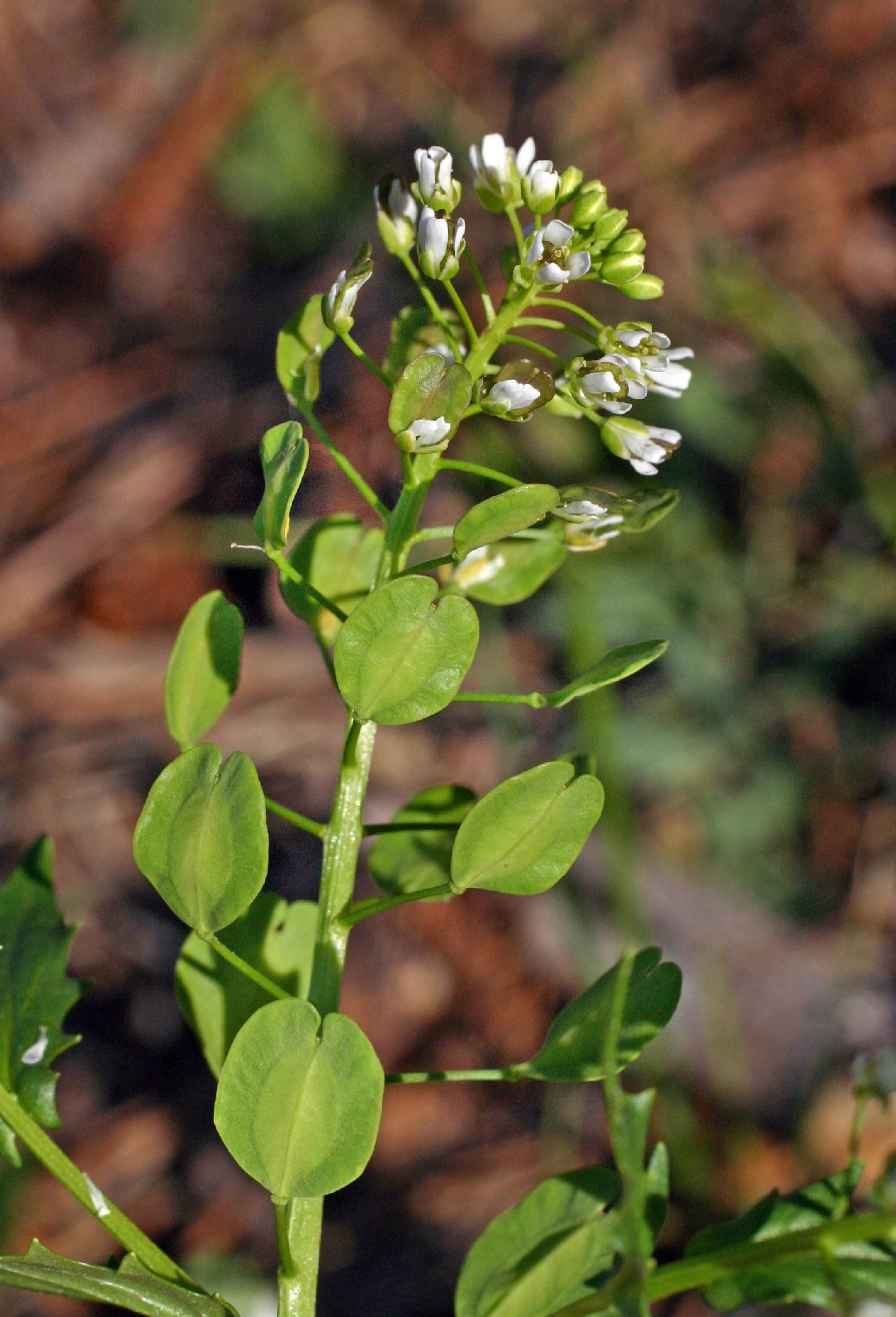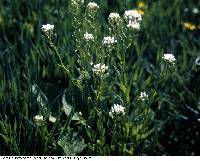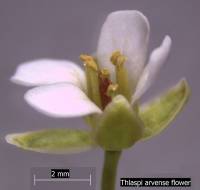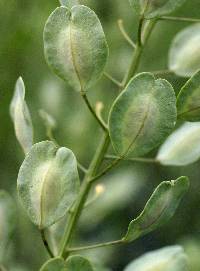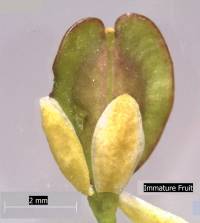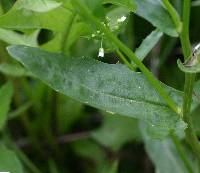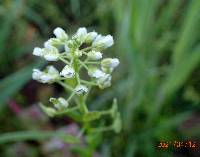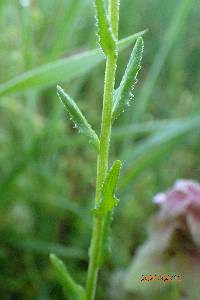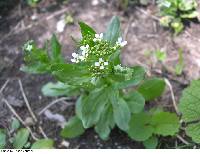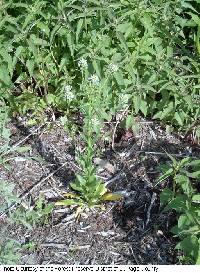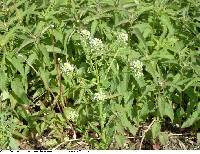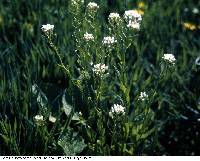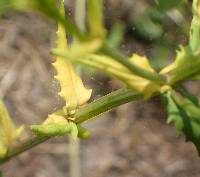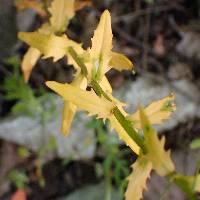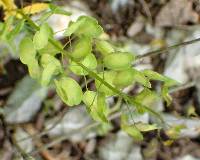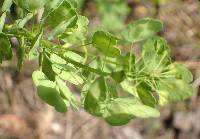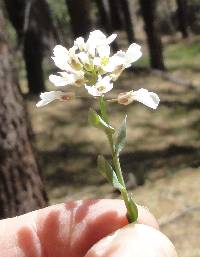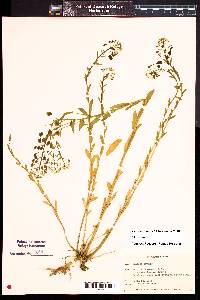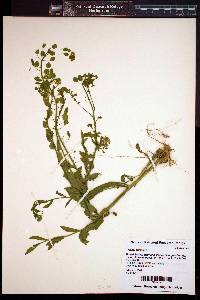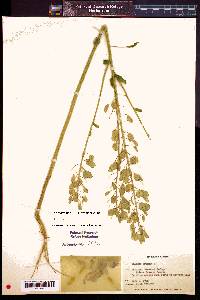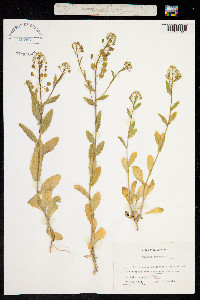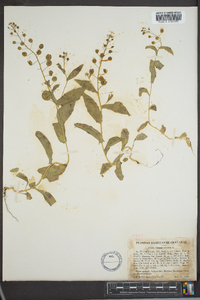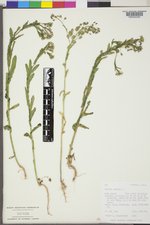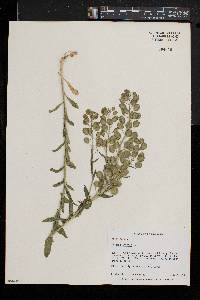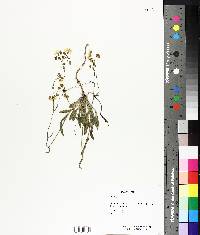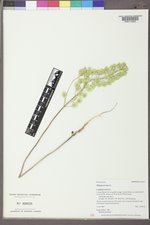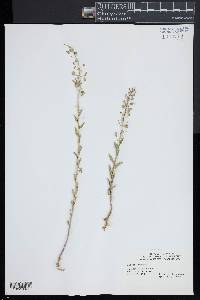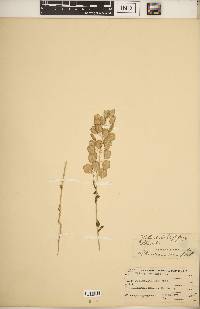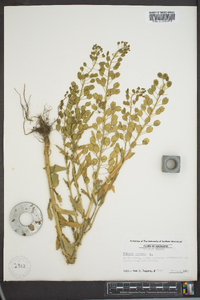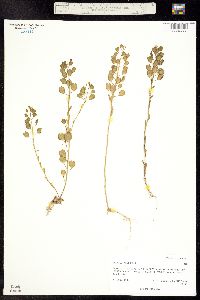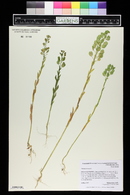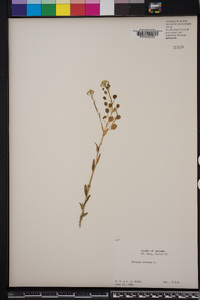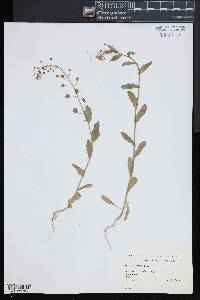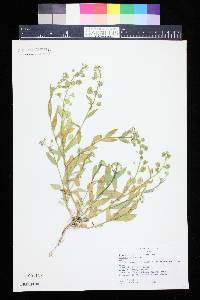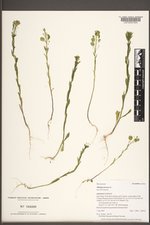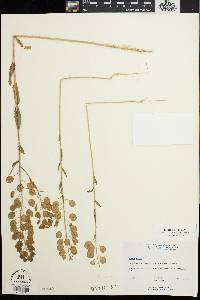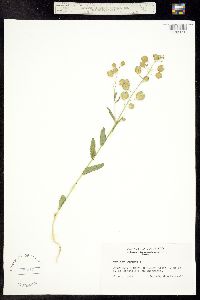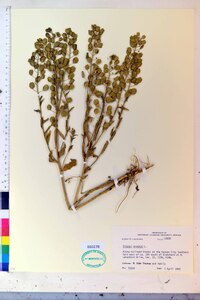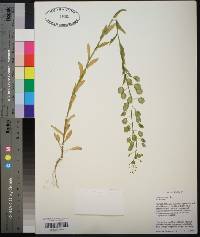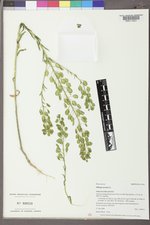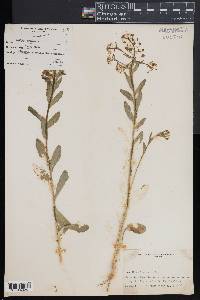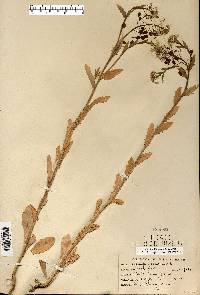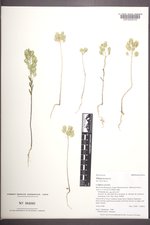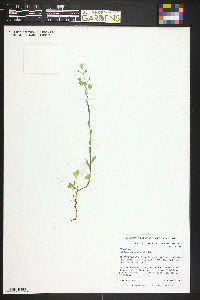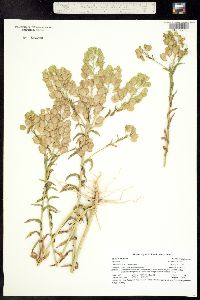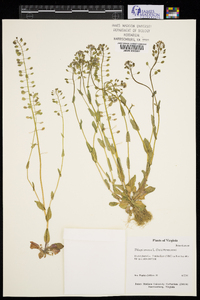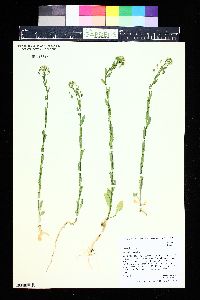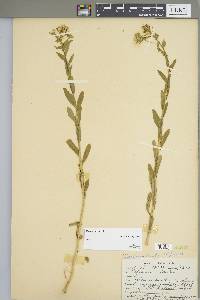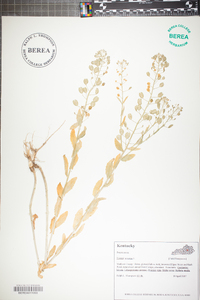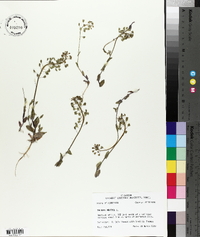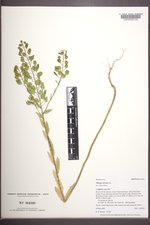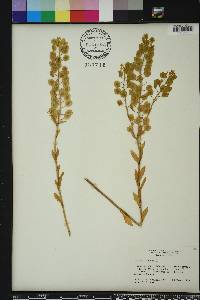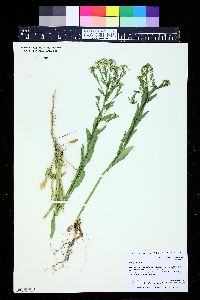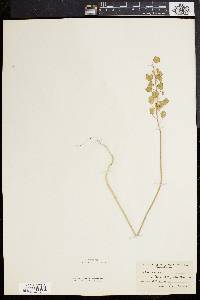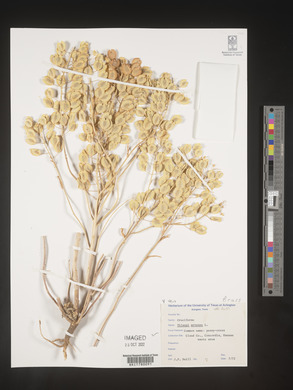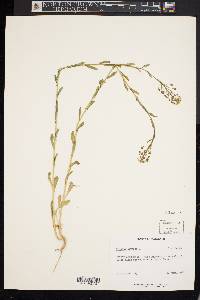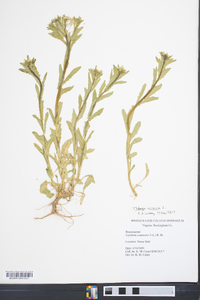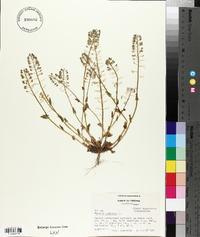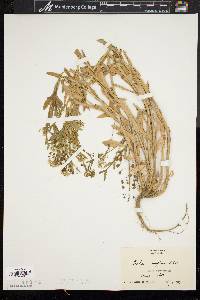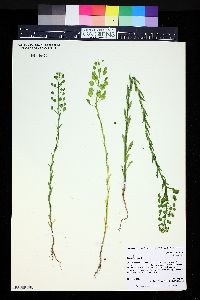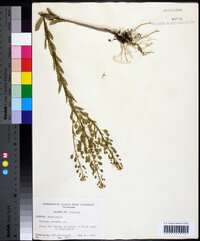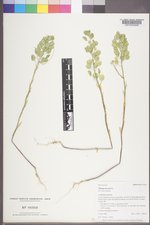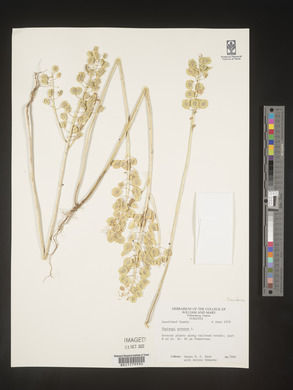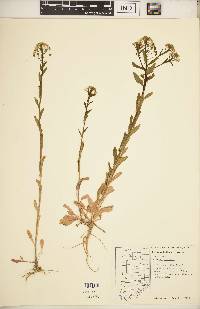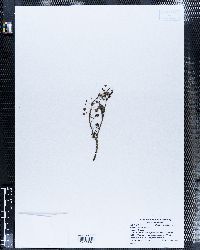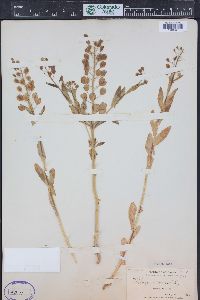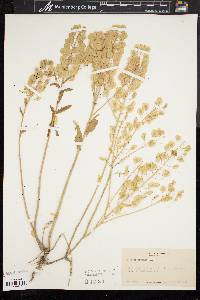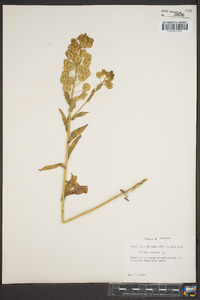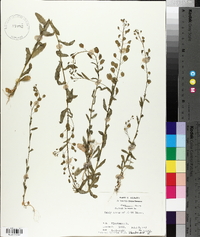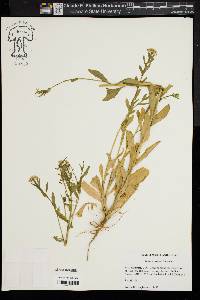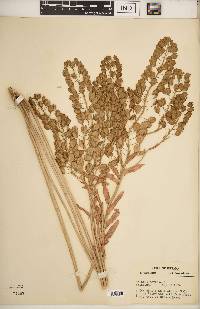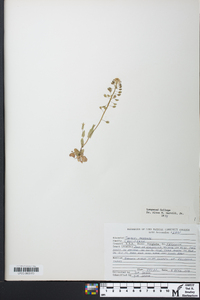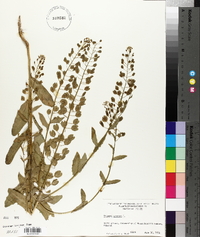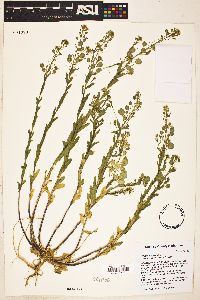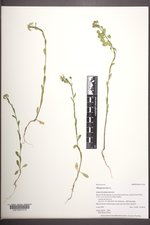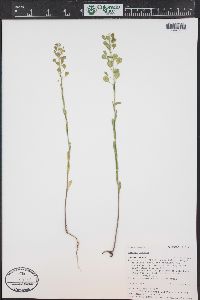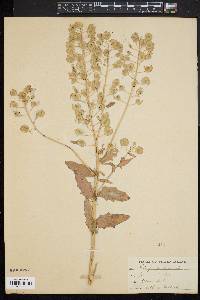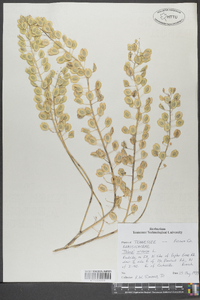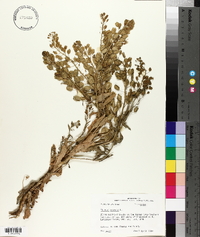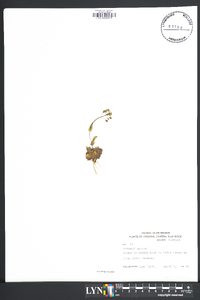
|
|
|
|
Family: Brassicaceae
Field Pennycress, more...fanweed, Frenchweed, pennycress, stinkweed
[Thlaspi arvensis] |
Plants (sometimes glaucous), glabrous throughout. Stems (0.9-)1.5-5.5(-8) dm. Basal leaves not rosulate; petiole 0.5-3 cm; blade oblanceolate, spatulate, or obovate, 1-5 cm × 4-23 mm, base attenuate or cuneate, margins entire, repand, or coarsely dentate, apex rounded. Cauline leaves: blade oblong, (0.5-)1.5-4 (-8) cm × (2-)5-15(-25) mm, apex rounded, obtuse, or subacute. Fruiting pedicels straight or slightly upcurved, (5-)9-13(-15) mm. Flowers: sepals (1.5-) 2-3(-3.3) × 1-1.5 mm; petals (2.4-)3-4.5(-5) × (0.8-) 1.1-1.7 mm, narrowed to clawlike base (ca. 1 mm), apex obtuse or emarginate; filaments (1-)1.5-2.2 mm; anthers 0.3-0.5 mm. Fruits obovate or suborbicular, (0.6-)0.9-2 cm × (5-)7-20 mm, base obtuse or rounded, apex deeply emarginate, notch ca. 5 mm deep; wings broad throughout, 1-1.5 mm wide basally, 3.5-5 mm wide apically; ovules 6-16 per ovary; style 0.1-0.3 mm. Seeds (1.2-)1.6-2(-2.3) × 1.1-1.3 mm, concentrically striate. 2n = 14. Flowering Mar-Aug. Roadsides, fields, waste places, lawns, gardens, railroad tracks, stream banks, bluffs, thickets, slopes, floodplains, woods; 0-2000 m; introduced; Alta., B.C., Man., N.B., Nfld. and Labr., N.W.T., N.S., Ont., P.E.I., Que., Sask., Yukon; Ala., Alaska, Ariz., Ark., Calif., Colo., Conn., Del., D.C., Fla., Ga., Idaho, Ill., Ind., Iowa, Kans., Ky., La., Maine, Md., Mass., Mich., Minn., Miss., Mo., Mont., Nebr., Nev., N.H., N.J., N.Mex., N.Y., N.C., N.Dak., Ohio, Okla., Oreg., Pa., R.I., S.C., S.Dak., Tenn., Tex., Utah, Vt., Va., Wash., W.Va., Wis., Wyo.; Europe; Asia. Thlaspi arvense is a cosmopolitan weed of Eurasian origin. Cattle feeding on it develop tainted milk.
Annual herb 10 cm - 0.5 m tall Stem: single or multiple, upright, branched above, purplish near base, ribbed. Flowers: in compact, branched clusters (racemes), which are borne terminally on the stems. Flower stalks to 1 cm long (longer in fruit). Sepals four, not touching (free), spreading to upright, whitish yellow along the margins, 2 mm long, 1 mm wide, egg-shaped. Petals four, white, 3 mm long, twice as long as sepals. Stamens six. Fruit: a pod (silicle), upright, 1 - 1.7 cm long and wide, roundish, tips deeply notched (deeper than wide), winged all around. Fruit stalks ascending, to about 2 cm long. Seeds numerous. Basal leaves: in a rosette, stalked, to 8 cm long, to 2 cm wide, spatula-shaped or oblong or narrowly reverse egg-shaped with a narrowly lobed base and rounded tip, shallowly toothed or lobed, soon wilting. Leaf stalks winged. Stem leaves: alternate, stalkless, clasping, about 6 cm long, about 2 cm wide, oblong to lance-shaped with pointed lobes at base, sometimes coarsely toothed. Similar species: No information at this time. Flowering: late March to late July Habitat and ecology: Introduced from Europe. A weed found in cultivated fields, waste ground, disturbed areas, and along roads and railroads. It is also found as a weed in nursery plots. Occurence in the Chicago region: non-native Etymology: Thlaspi is the Greek word for cress. Arvense means "of farmed or cultivated land." Author: The Morton Arboretum FNA 2010, Jepson 2012, Kearney and Peebles 1969 Duration: Annual Nativity: Non-Native Lifeform: Forb/Herb General: Herbaceous annuals, to 80 cm tall, stems erect, unbranched or branched distally, herbage glaucous to glabrous throughout, plants with pungent, watery sap, often fetid when crushed. Leaves: Alternate, basal and cauline; basal leaves not in a rosette, blades oblanceolate, spatulate, or obovate, 1-5 cm long and 4-23 mm wide, margins entire, repand, or coarsely dentate, bases attenuate or cuneate, apices rounded, borne on petioles 0.5-3 cm long, cauline leaves oblong, 0.5-8 cm long and 2-25 mm wide, apices rounded, obtuse, or subacute. Flowers: White, with 4 petals forming a cross, petals 2-5 mm long and to 2 mm wide, narrowing to a clawlike base about 1 mm long, apices obtuse or with a notch at the apex (emarginate), sepals 4, free, 1.5-3 mm long and 1-1.5 mm wide, stamens 6 with 4 long and 2 short, filaments to 2 mm long, anthers to 0.5 mm long, ovary solitary and superior, ovules 6-16 per ovary, generally 2-chambered with a septum connecting 2 parietal placentas, styles solitary, persistent, style 0.1-0.3 mm long, flowers borne in elongated racemes at branch tips. Fruits: Obovate or suborbicular siliques dehiscent into 2 valves and a septum, flattened, 0.5-2 cm long and 5-20 mm wide, wings broad throughout, 1-1.5 mm wide basally, 3.5-5 mm wide apically, silique apices deeply emarginate with the notch about 5 mm deep, with Ecology: Introduced, found on roadsides, in fields, waste places, lawns, gardens, railroad tracks, stream banks, bluffs, thickets, slopes, floodplains, and woods, to 6,500 ft (1981 m); flowering March-August. Distribution: Widespread across almost all of the United States, including the southwest, not present in Alabama only. Notes: The relatively small and inconspicuous white flowers of this species turn into rather large, winged siliques. The keys to this species are the glabrous herbage, broadly winged fruits with the wing 3.5-5 mm wide apically, and the concentrically striate seeds. Look for this species in Arizona in Navajo and Coconino counties in Arizona. Ethnobotany: Infusion of plant taken for sore throats, leaves used for food, and seeds used in a variety of ways. Synonyms: Numerous, see Tropicos Editor: LCrumbacher2012 Etymology: Thlaspi comes from the Greek thlaein, "to crush," from the flattened silicle, and the Greek name for a cress, and arvense means of the fields. Glabrous annual or winter-annual 1-5 dm; cauline lvs sessile, oblong to lanceolate, entire or few-toothed, bearing at base 2 narrow, divergent, acute auricles 1-5 mm; fls 3 mm wide, the pet twice as long as the sep; mature pedicels ascending; frs orbicular to broadly elliptic, 10-17 mm, winged all around, deeply (2-3 mm) notched; seeds concentrically ridged-striate, numerous in each locule; 2n=14. Native of Europe, commonly established in waste places throughout much of N. Amer. Apr.-June. Gleason, Henry A. & Cronquist, Arthur J. 1991. Manual of vascular plants of northeastern United States and adjacent Canada. lxxv + 910 pp. ©The New York Botanical Garden. All rights reserved. Used by permission. From Flora of Indiana (1940) by Charles C. Deam Local in many parts of the state and now possibly established in all parts, although there are no reports from the Lake Michigan area where we would most expect to find it. Most of my specimens are from railroad ballast. Hansen (Proc. Indiana Acad. Sci. 1923: 214-215. 1924) reports it from Randolph and Switzerland Counties and calls attention to its tendency to become a weed. I have found only a few specimens at a place except along an abandoned road in Switzerland County where it was frequent. …… Indiana Coefficient of Conservatism: C = null, non-native Wetland Indicator Status: FACU |
|
|
|
This project was made possible in part by the Institute of Museum and Library Services [MG-70-19-0057-19].
Powered by Symbiota

